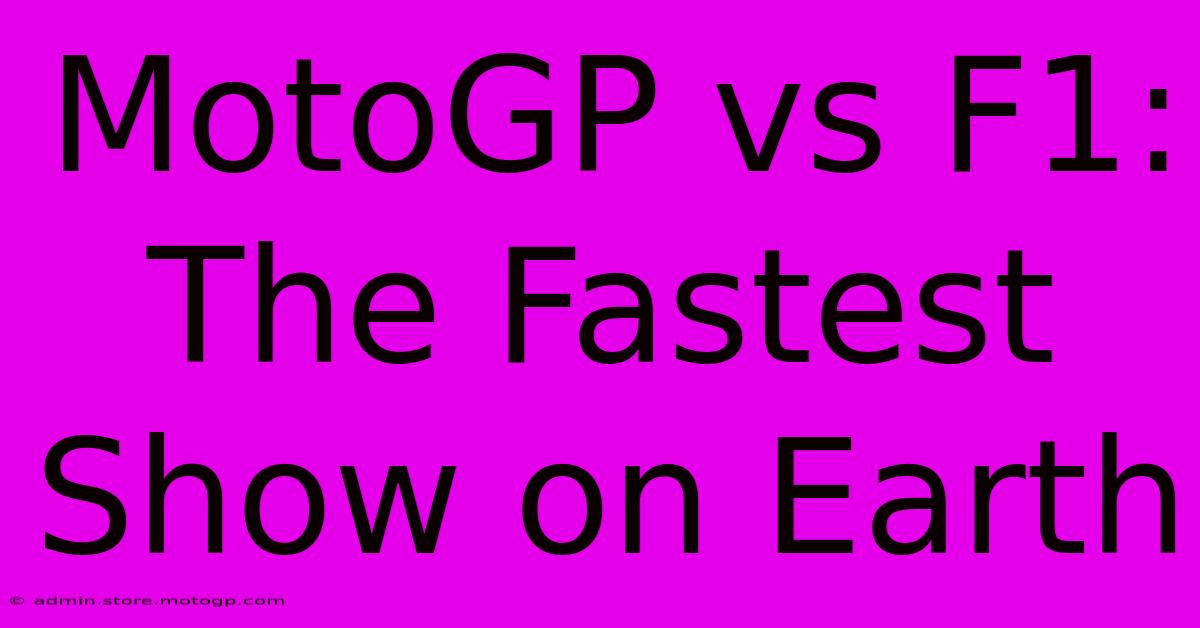MotoGP Vs F1: The Fastest Show On Earth

Table of Contents
MotoGP vs F1: The Fastest Show on Earth?
The roar of the engines, the smell of burning rubber, the heart-stopping speeds – motorsports offer a thrilling spectacle. But when it comes to crowning the "fastest show on earth," the debate often boils down to two titans: MotoGP and Formula 1. Both feature incredible feats of engineering and human skill, pushing the boundaries of speed and technology, but their differences are significant and contribute to their unique appeal.
Speed Demons: A Head-to-Head Comparison
While the simple answer of "which is faster?" is difficult to definitively answer due to variable track layouts and conditions, let's delve into some key aspects:
Top Speed:
F1 cars generally hold the edge in terms of sheer top speed. Their powerful engines and aerodynamic designs allow them to reach speeds exceeding 230 mph (370 km/h) on certain straights.
MotoGP bikes, on the other hand, are limited by their two-wheeled nature and tire grip. While they can achieve incredibly high speeds, generally in the range of 200-220 mph (320-350 km/h), they are more susceptible to instability at such high velocities.
Cornering Speed:
This is where MotoGP truly shines. The incredible agility and lean angles of MotoGP bikes allow them to navigate corners at astonishing speeds, often exceeding the cornering speeds of F1 cars. The skill of the riders is paramount here, demonstrating unbelievable control and balance.
Lap Times:
The overall lap time, a crucial measure of speed and efficiency, is highly track-dependent. Some tracks favor F1's speed on the straights, while others better suit the agility of MotoGP bikes. Therefore, a definitive "faster" based on lap times is unreliable without specifying the circuit.
G-Forces:
Both disciplines subject drivers and riders to immense G-forces. While F1 cars may experience higher sustained G-forces during cornering, MotoGP riders experience incredibly intense and fluctuating G-forces due to the bike's lean angles and rapid changes in direction. The physical demands on MotoGP riders are exceptionally high.
Beyond the Numbers: The Essence of the Competition
The difference between MotoGP and F1 extends far beyond mere speed statistics.
The Human Element:
MotoGP showcases an unparalleled level of rider skill and bravery. Balancing a machine at extreme lean angles at breakneck speeds demands extraordinary talent and reflexes. A single mistake can have devastating consequences.
F1 also demands incredible skill, but the car provides more support and stability. The drivers still need precision and quick thinking, but the margin for error is slightly larger.
Technological Marvels:
Both series represent cutting-edge engineering and technological innovation. F1 is known for its complex aerodynamics, sophisticated engine management systems, and hybrid power units. MotoGP pushes the boundaries of tire technology, chassis design, and engine performance within the constraints of two wheels.
The Spectacle:
Both offer a captivating spectacle. The sheer speed of F1 is awe-inspiring, while the breathtaking agility and close racing of MotoGP generates intense drama.
The Verdict: No Single Winner
Ultimately, declaring a single "fastest show on earth" is subjective. F1 often holds the edge in raw top speed on certain straights, while MotoGP demonstrates superior cornering speed and arguably more exhilarating displays of rider skill. Both are incredible feats of engineering and human performance, offering unique thrills and captivating audiences worldwide. The best choice depends entirely on individual preference. So, instead of choosing a winner, appreciate the distinct excellence of both MotoGP and F1!

Thank you for visiting our website wich cover about MotoGP Vs F1: The Fastest Show On Earth. We hope the information provided has been useful to you. Feel free to contact us if you have any questions or need further assistance. See you next time and dont miss to bookmark.
Featured Posts
-
Behind The Scenes With Famous Motorcycle Riders
Feb 18, 2025
-
An Epic Showdown Who Won The Grand Prix Yesterday
Feb 18, 2025
-
F1 Austin Parking Deals You Cant Miss
Feb 18, 2025
-
Experience The Energy Cota Merchandise Collection
Feb 18, 2025
-
Accident Moto Gp How To Stay Safe While Watching
Feb 18, 2025
